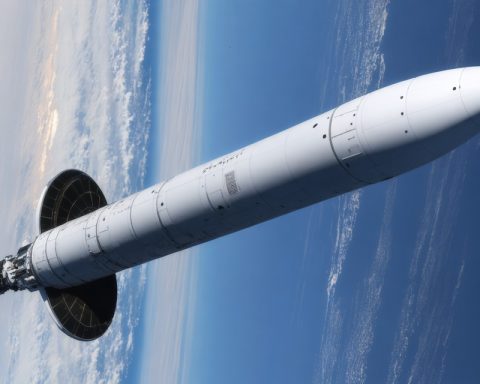- SpaceX’s Starship embarks on its eighth test flight aiming to revolutionize space travel with enhanced designs and goals.
- New improvements include fortified forward flaps for reentry and a propulsion system with 25% more propellant, enhancing its reusability.
- This mission will attempt historic firsts, like payload deployment and reentry trials aimed at upper stage recovery.
- The Super Heavy booster features refined avionics for an ambitious return, potentially switching from splashdowns to soft landings.
- Each development diminishes failures, serving as stepping stones toward mastering precision in space operations.
- The Starship endeavor symbolizes SpaceX’s pursuit of sustainable, reusable rocketry—paving the path toward Mars and monumental achievements in space exploration.
A shimmering silhouette poised to touch the heavens, SpaceX’s Starship gears up for its ambitious eighth flight test. This groundbreaking journey isn’t just another test—it aims to redefine the future of space travel with improved designs and innovative goals. Picture this: a rocket that not only pierces the cosmic veil but returns, ready to fly again and again.
The cracks of past failures have formed paving stones toward success. After an intense analysis of the seventh flight mishap, SpaceX has chiseled out a new path with crucial hardware and operational enhancements. Each tweak—like the augmented forward flaps now better shielded against searing reentry heat and a more robust propulsion system boasting 25% more propellant volume—positions Starship closer to its lofty vision of swift, reliable reuse.
On the horizon for this flight lies the promise of triumphs not achieved in prior launches. The star of the show isn’t just Starship’s skyward symphony but the opportunities it unveils: the bold first attempt at payload deployment and daring reentry experiments tailored to bring the upper stage home for a spectacular catch. As these metallic gladiators prepare to clash with gravity’s pull, they will escort four Starlink simulators—technologic harbingers of data-transmitting constellations yet to orbit.
The Super Heavy booster, a colossus of power with newly refined avionics, stands ready not merely to lift but also to land. Its journey back will be a sight—to descend from supersonic speeds echoed by thunderous sonic booms, reverberating like applause across the Gulf of America if its trajectory permits a catch rather than a splash.
In this delicate ballet of engineering, every component must sync perfectly; one misstep, however minor, can enforce a watery curtain call over the Gulf. Yet, within this dance of precision lies the beating heart of progress.
The world waits, eyes drawn skyward, as the Screen brings this cosmic theater to life—a digital front row to Earth’s audacious reach into the stars. Transformation thrives by embracing risks—adopting each lesson learned as another stepping stone—and the Starship project stands as a beacon of this bold inquiry. As SpaceX pushes the envelope of reusable rocketry, they not only chase Mars—they chase history.
The Next Giant Leap: What’s New in SpaceX’s Starship’s Eighth Flight Test?
Overview
SpaceX’s Starship is gearing up for its eighth flight test, a venture that represents more than just technological refinement—it’s a significant leap toward redefining space travel. Featuring enhancements and a focus on reusable rocketry, this mission could transform our approach to reaching the stars.
Key Improvements and Innovations
1. Design Enhancements:
– Forward Flaps: Improved to withstand the intense heat during reentry, providing better heat shielding.
– Propulsion System: Now with 25% more propellant volume, enhancing thrust capabilities for both launch and landing phases.
2. Operational Goals:
– Payload Deployment: This flight will attempt to deploy a payload for the first time, testing capabilities for future missions.
– Reentry Innovations: New experiments are focused on returning the upper stage of the rocket for a potential catch, rather than a splashdown.
3. Super Heavy Booster:
– Featuring refined avionics, this boon to the flight will demonstrate its ability to land safely post-launch, a crucial step in boosting reusability and reducing costs.
Real-World Use Cases
– Satellite Deployment: With the on-board Starlink simulators, SpaceX aims to perfect satellite placement for future constellations that will enhance global internet connectivity.
– Mars Colonization: These advances bring SpaceX closer to its goal of launching missions to Mars, potentially enabling human colonization of the Red Planet.
Market Forecasts & Industry Trends
– Reusable Rockets: The push toward fully reusable rockets marks a significant shift in the space industry, promising to lower costs and make space accessible to more entities.
– Private Space Travel: SpaceX is paving the path for private ventures into space, with anticipated collaborations and contracts on the horizon that could redefine commercial space tourism.
Controversies & Limitations
– Environmental Concerns: Frequent launches from coastal areas raise environmental concerns, such as the impact on marine life and local ecosystems.
– Technical Risks: The complexity of reentry and landing poses significant technical challenges. Each failure serves as both a setback and a learning opportunity for future enhancements.
Pros & Cons Overview
Pros:
– Advancements in reusable technology could drastically reduce the cost of space travel.
– Successful payload deployment increases the mission’s potential applications.
– Offers significant progress towards interplanetary travel, particularly to Mars.
Cons:
– Technical challenges related to reentry and reuse need refining.
– Environmental impacts require careful consideration and mitigation.
Insights & Predictions
Experts predict that SpaceX’s focus on reusability will fundamentally alter the economics of space exploration. The successful deployment and return of Starship stages will set new standards for both government and commercial space operations.
Actionable Recommendations
– For Entrepreneurs: Monitor developments in reusable rockets for potential new market opportunities in satellite deployment and space tourism.
– For Environmentalists: Engage with space agencies to advocate for and develop strategies to mitigate environmental impact.
Conclusion
SpaceX’s ongoing innovations in the Starship program represent a transformational period in space exploration. As the company refines its technology and processes, the possibilities for space travel and colonization expand, promising a future where reaching the stars is not a distant dream but a tangible reality.
For more information about SpaceX and their groundbreaking work, visit SpaceX.











